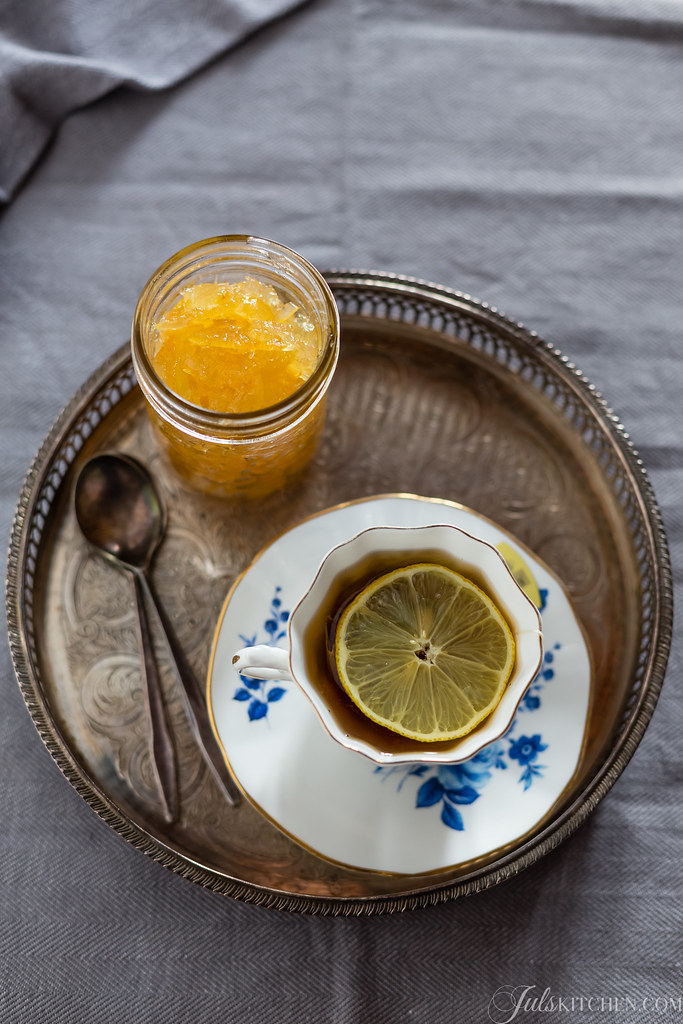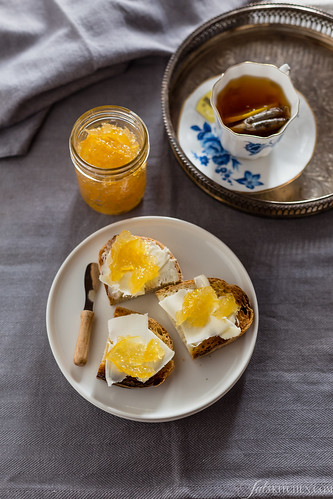The charm of citrus fruit. Bergamot marmalade
Since Molly and Emiko warmly suggested to read The Land Where Lemons Grow: The Story of Italy and its Citrus Fruit, written by Helena Attlee, garden writer specialized in the cultural history of Italian gardens, I started noticing citruses everywhere. Beautiful leafy lemons are staring at me from the farmers’ market stalls, glistening jars of British marmalade are lined on the shelves of quaint little shops, blood and blond oranges are pressed in front of my eyes in every bar and I finally find unusual and rare citruses at the local market.

The Land Where Lemons Grow is a charming excursion through history and through Italian citrus groves, from the giardini of the Medici’s villas, to the lemon terrazze in Amalfi or Lake of Garda limonaie up until the Conca d’Oro in Sicily. It explores the diffusion of lemons, oranges, bitter oranges, blood oranges, citrons and bergamots in the Italian life, culture and culinary heritage. Reading those pages you are intoxicated by the smell of zagara and by Helena Attlee’s sensual prose. It is an informative and evocative book.

But let’s get back to my rare findings at the market: a few weeks ago I spotted bergamots. Real bergamots from Calabria. I was immediately hooked. Bergamots are defined as green gold, the most valuable citrus in the world.
Bergamots are a natural cross-pollination between a lemon tree and a sour orange that occurred for the first time ever in Calabria in the mid seventeenth century. The bergamot tree grows successfully just in a thin strip of land that runs for 75 kilometers from Villa San Giovanni on the Tyrrenian coast to Brancaleone on the Ionian sea. It produces its unrivaled fruits thanks to extreme weather conditions, which grant a bergamot rich in essential oils.
I was immediately captured by Helena Attlee’s description of bergamots, real free spirits, so I’m copying her imaginative prose here, for your pleasure and mine.
Anything goes in a bergamot grove. Trees are pruned very lightly only once a year and some of them grow to over four meters high. They are carefree, liberated, untidy and entirely organic, the hippies of the citrus world. It is the essential oil stored in the pores just beneath the surface of the skin that makes bergamot so valuable.
It has been the precious essential oil that made bergamots famous all over the world as a fixing agent in the perfume industry. Just imagine, the celebrated Eau de Cologne was invented by an Italian perfumer, Giovanni Maria Farina, who perfected the art of distilling the alcohol in Germany in the XVIII century. He describes his new bergamot-based perfume as the scent of a spring morning in Italy, of a mountain narcissus and citrus blossom after rain.
Now I want to leave behind every other perfume and douse myself in Eau de Cologne.


Since the XIX century bergamot oil found a new use: it gave its distinct aroma and flavour to Earl Grey, probably the most famous of English teas, made from a blend of dark China teas infused with the bergamot oil and peel. My dear friend Regula is a fond estimator, she cannot begin her day without a steaming cup of Earl Grey tea. This is yet another reason to love bergamots, as their smell reminds me of our breakfasts together and all the related chats over a cup of tea.
In the XIX century bergamots were used in the perfume art and for making Earl Grey tea, but as soon as scientists and doctors discovered its powerful antiseptic and antibacterial qualities, the bergamot oil acquired a key role in hospitals as disinfectant.
Bergamot marmalade
Bergamot is so acid in its natural form that cooks ignored it for centuries. It was even categorized as a toxic substance. Recently producers of quality bergamots from Calabria fought to remove this wrong toxic label and nowadays they are developing new interesting products to promote other uses of bergamot, which are not just related to extracting its precious essential oil: now you can find also bergamot bases marmalades, cordials and syrups.
I decided to begin my exploration with the easiest preparation, a bright yellow bergamot marmalade, where the citrus note is persistent and fresh, but the unmistakable incense-like flavour of bergamot lingers well after your first spoon. I was inspired by David Leibovitz’s bergamot marmalade, but played a bit with the amount of sugar and time of cooking.
It’s a precious and unique marmalade for breakfast which pairs naturally with a cup of Earl Grey and a few slices of toasted bread. Do not forget the butter, which mellows the intense bergamot flavour.
Bergamot marmalade
Print Recipe Pin Recipe Share by EmailIngredients
- 1,8 kg 4 lb of bergamots
- 1,3 kg 6 1/2 cups - 2,87 lb of sugar
- 500 ml 2,2 cups - 16,9 fl oz of water
Instructions
- Wash thoroughly the bergamots under running water and dry them.
- Quarter each bergamot, trim off the stem ends and remove the seeds. Keep them aside.
- Slice as thinly as possible the bergamots and collect flesh, rind and juice in a big pot filled with water. Bring to a boil and let boil for five minutes, then drain well.
- Return the bergamots to the pot, add the sugar, por in the water and stir thoroughly. Collect seed and pith in a cheesecloth, form a little sachet, close it with a string and add it to the pot. Seeds contain naturally pectin, which will help you get a thick marmalade.
- Bring the citrus fruit to a boil on medium heat, then lower the temperature to the minimum and simmer gently for about two hours. Check the doneness of the marmalade with a little saucer. Pour a drop of marmalade onto a cold saucer from the fridge. If it solidifies and does not slip away when you tilt the saucer, it is ready to be put into sterilized jars.


Link love
Have you ever tried bergamots? Could you recognize their unmistakable aroma? Here’s some interesting readings for you if you, like me, have fallen in love with this rare citrus fruit.
- A great review of Helena Attlee’s book on the Telegraph by Anna del Conte. Attlee, who knows and loves Italy and the Italians, takes the reader through the country’s scented gardens with her sharp descriptions, pertinent stories and quotes and intriguing recipes. I was there with her.
- David Leibovitz’s bergamot marmalade, inspired by The Independent Bergamot and cedro marmalade by Skye Gyngell.
- Yet another bergamot marmalade, this time by Bois the Jasmin, a blog where Victoria shares her love for perfume, food and other sensory pleasures. I just discovered her blog and I am already immensely in love with her unique approach.
- Emiko has already written something about her love for Helena Attlee’s book and her discovery of citron at the market. She also made a cedrata, a citron drink, for Food52.







that bitter taste how strong must be after marmalade is done?i blanched the bergamot 3 times.Rinsed very very good every time.
It is actually quite bitter, you might like it or not. I do love bitter taste, but it is very personal!
Having only recently discovered fresh Bergamot on sale in Waitrose, while visiting London from our home in the Lakes, we bought some with a view to perking up our Earl Grey tea caddy with some peel and using the rest for marmalade. Our tea is now how I remember Earl Grey used to be.
Have been perplexed at all the marmalade recipes though, which instruct to boil the quartered fruit in water… and then THROW THE WATER AWAY??? Why? To remove that wonderful bitter flavour? Pointless or what?
Despite having a sweet tooth, I just LOVE bitter foods and flavours. Gapefruit & it’s marmalade, chicory, cardoons (wow!), Campari, Fernet Branca & Gentiana (an Italian digestivo made from gentian root steeped in alcohol or wine)…yum, yum. So I just chopped (actually processed) the whole lot (everything including pips) into a pan, added water, sugar and just got cracking. Simple, quick, very easy. Result… looks a great colour and tastes… amazing. Requires just a thin spread on toast to wake up your taste buds; so, economical and reduced sugar intake.
it is all a matter of taste. I am totally like you, I love the bitter taste in food and drinks. Have you ever tried the original Chinotto, from Savona? it is a drink made with chinotti, a local type of citrus. Bitter and refreshing in summer!
I live in Bodrum, Turkey for over 25 years. Retired New Yorker. In the early days at the farmers market I discovered Bergamot years ago. It was commonly grown but the new building throughout Turkey is making it rare. What we have here is the really ugly green and yellow bergamot which does not resemble the Italian variety. Ours looks prehistoric. As we speak I am making marmalade from 3 of them weighing 2 kg. I wish I could send a photo
wow! 3 bergamots make 2 kilos total! they must be massive! I hope the smell was divine!
Thank you! I thought I was the only one bewildered by this. I actually thought maybe I misunderstood the directions. The only reason I’m trying out making my own marmalade is because I can’t get my favorite brand anymore and the others just aren’t bitter enough! Will be trying it your way.
Thank you for this wonderful post and recipe! I love the scent and taste of bergamot. Earl Grey tea is my absolute favorite so I am really looking forward to trying out this marmalade. And that lovely poetic quote from Helena Atlee was just perfect. 🙂
thank you so so much Lora!
Thank you very much for this lovely article. I too have read Helena Atlee’s book “The Land where Lemons grow” which I really enjoyed. I was amazed when I discovered that my local organic shop was selling bergamots from “Italy” ( I’m assuming Calabria). Knowing that these are the most “precious” of all citrus fruits I bought 2 kg for roughly EUR 10 straight away. I now want to turn it into a marmalade. …and you are right the smell is delicate but wonderful.
So happy you arrived here following the smell of bergamot!
Just found some in our local bio store in Brittany, grown in Morocco, at about €3.90 a kg, I think. They were billed as ‘citron bergamot’ among two other types of lemon, and real citrons. I didn’t really associate them with the Earl Grey flavouring and bought three just for their beauty. Having researched them I now realise I must go back and buy a big bag full to make marmalade and other things! I too was puzzled about throwing out the water after boiling the slices, surely you lose a lot of the juice that way? When I used to make orange marmalade I boiled the whole fruit, then chopped it up and re-cooked it in the reserved water with sugar, a time-honoured method and very leisurely over at least two days.
Hi Lucy, go get those bergamots!!
As for the marmalade procedure, there are endless recipes, I suppose. If you loved your version, use that for the bergamots, too! I found this procedure and loved it, especially because bergamots can be very very bitter, and throwing out the water softens the bitterness. Let me know when you make it!
I make it with half marmalade orange half bergamot and simmer the skins for about 2 hours I think they would be hard if only simmered for 5min..as per normal marmalade in river cottage book
Hello Sue, this is just a different procedure, have you tried it? The marmalade simmers for 2 hours after the first 5 minutes of simmering.